Abstract
Superior mesenteric artery (SMA) syndrome is a rare condition that must be differentiated from other gastrointestinal diseases manifesting as upper abdominal pain, nausea, or vomiting. The description of SMA syndrome is compression of the third portion of the duodenum by the SMA and the abdominal aorta. SMA syndrome is managed with nasoenteral nutrition or surgical strategies such as laparoscopic duodenojejunostomy. However, SMA syndrome treated using enteral nutrition by percutaneous radiologic gastrojejunostomy has not been reported. Here, we report our experience of successfully managing a case of SMA syndrome with percutaneous radiologic gastrojejunostomy.
References
1. Fraser JD, St Peter SD, Hughes JH, Swain JM. Laparoscopic duodenojejunostomy for superior mesenteric artery syndrome. JSLS. 2009; 13:254–259.
2. Rokitansky CV. Handbuch der pathologischen anatomie. Wien, Braumüller and Seidel;1842.
4. Laffont I, Bensmail D, Rech C, Prigent G, Loubert G, Dizien O. Late superior mesenteric artery syndrome in paraplegia: case report and review. Spinal Cord. 2002; 40:88–91.

5. Sato H, Tanaka T. Acute gastric dilatation due to a superior mesenteric artery syndrome: an autopsy case. BMC Gastroenterol. 2014; 14:37.

6. Lee CW, Park MI, Park SJ, et al. A case of superior mesenteric artery syndrome caused by anorexia nervosa. Korean J Gastroenterol. 2011; 58:280–283.

7. Lee TH, Lee JS, Jo Y, et al. Superior mesenteric artery syndrome: where do we stand today? J Gastrointest Surg. 2012; 16:2203–2211.

8. Merrett ND, Wilson RB, Cosman P, Biankin AV. Superior mesenteric artery syndrome: diagnosis and treatment strategies. J Gastrointest Surg. 2009; 13:287–292.

9. Boulton-Jones JR, Lewis J, Jobling JC, Teahon K. Experience of post-pyloric feeding in seriously ill patients in clinical practice. Clin Nutr. 2004; 23:35–41.

11. Thurley PD, Hopper MA, Jobling JC, Teahon K. Fluoroscopic insertion of post-pyloric feeding tubes: success rates and complications. Clin Radiol. 2008; 63:543–548.

12. Pearce CB, Duncan HD. Enteral feeding. Nasogastric, nasojejunal, percutaneous endoscopic gastrostomy, or jejunostomy: its indications and limitations. Postgrad Med J. 2002; 78:198–204.

13. Lai PB, Pang PC, Chan SK, Lau WY. Necrosis of the nasal ala after improper taping of a nasogastric tube. Int J Clin Pract. 2001; 55:145.
14. Kirby DF, Delegge MH, Fleming CR. American Gastroenterological Association technical review on tube feeding for enteral nutrition. Gastroenterology. 1995; 108:1282–1301.

15. Turrentine FE, Wang H, Simpson VB, Jones RS. Surgical risk factors, morbidity, and mortality in elderly patients. J Am Coll Surg. 2006; 203:865–877.

16. Li G, Warner M, Lang BH, Huang L, Sun LS. Epidemiology of anes-thesia-related mortality in the United States, 1999–2005. Anesthesiology. 2009; 110:759–765.

17. Kim SW, Han HS, Jung HW, et al. Multidimensional frailty score for the prediction of postoperative mortality risk. JAMA Surg. 2014; 149:633–640.

18. Pedersen T. Complications and death following anaesthesia. A prospective study with special reference to the influence of patient-, anaesthesia-, and surgery-related risk factors. Dan Med Bull. 1994; 41:319–331.
19. Shin KH, Shin JH, Song HY, Yang ZQ, Kim JH, Kim KR. Primary and conversion percutaneous gastrojejunostomy under fluoroscopic guidance:10 years of experience. Clin Imaging. 2008; 32:274–279.
20. Shin JH, Park AW. Updates on percutaneous radiologic gastrostomy/gastrojejunostomy and jejunostomy. Gut Liver. 2010; 4(Suppl 1):S25–S31.

21. Given MF, Hanson JJ, Lee MJ. Interventional radiology techniques for provision of enteral feeding. Cardiovasc Intervent Radiol. 2005; 28:692–703.

22. Barkmeier JM, Trerotola SO, Wiebke EA, et al. Percutaneous radiologic, surgical endoscopic, and percutaneous endoscopic gastrostomy/gastrojejunostomy: comparative study and cost analysis. Cardiovasc Intervent Radiol. 1998; 21:324–328.

23. Bazarah SM, Al-Rawas M, Akbar H, Qari Y. Percutaneous gastrostomy and gastrojejunostomy: radiological and endoscopic approach. Ann Saudi Med. 2002; 22:38–42.

24. Wollman B, D'Agostino HB, Walus-Wigle JR, Easter DW, Beale A. Radiologic, endoscopic, and surgical gastrostomy: an institutional evaluation and metaanalysis of the literature. Radiology. 1995; 197:699–704.

25. Faries MB, Rombeau JL. Use of gastrostomy and combined gastrojejunostomy tubes for enteral feeding. World J Surg. 1999; 23:603–607.

26. Mack LA, Kaklamanos IG, Livingstone AS, et al. Gastric decompression and enteral feeding through a double-lumen gastrojejunostomy tube improves outcomes after pancreaticoduodenectomy. Ann Surg. 2004; 240:845–851.

27. Li Y, Wang Z, Ni X, et al. Double percutaneous endoscopic gastrojejunostomy tubes for decompression and refeeding together with enteral nutrients: three case reports and a review of the literature. Surg Laparosc Endosc Percutan Tech. 2009; 19:e167–e170.
Fig. 1.
A distended and enlarged stomach dropped into the pelvic cavity. The silhouette of the stomach is noted at the level of the second sacral vertebra (arrows).
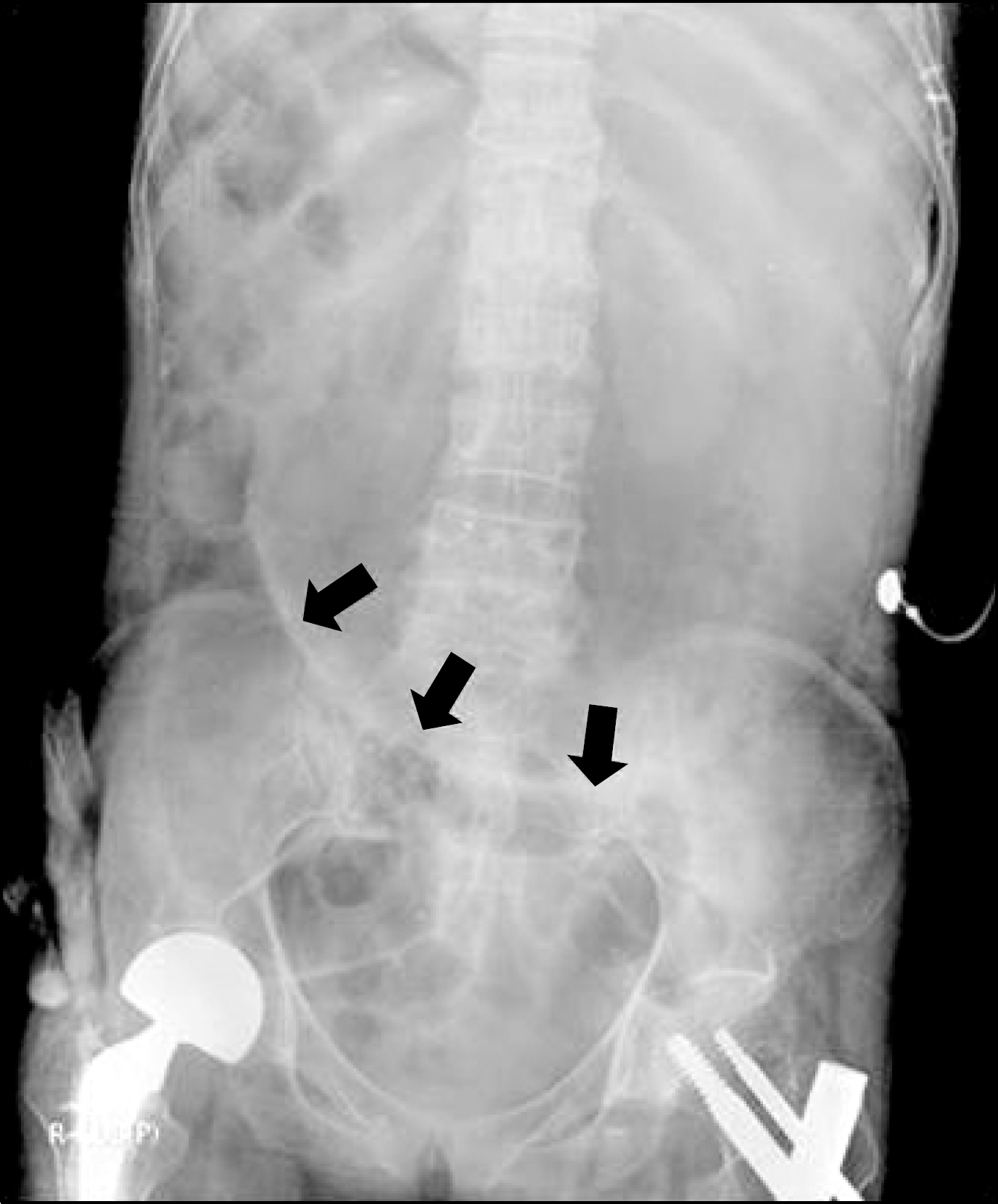
Fig. 2.
Abdominal CT. (A) Axial CT image of the abdomen demonstrates massive dilatation of the stomach and proximal duodenum. (B) Sagittal-view CT shows the compressed duodenum between the superior mesenteric artery and the abdominal aorta (white circle).
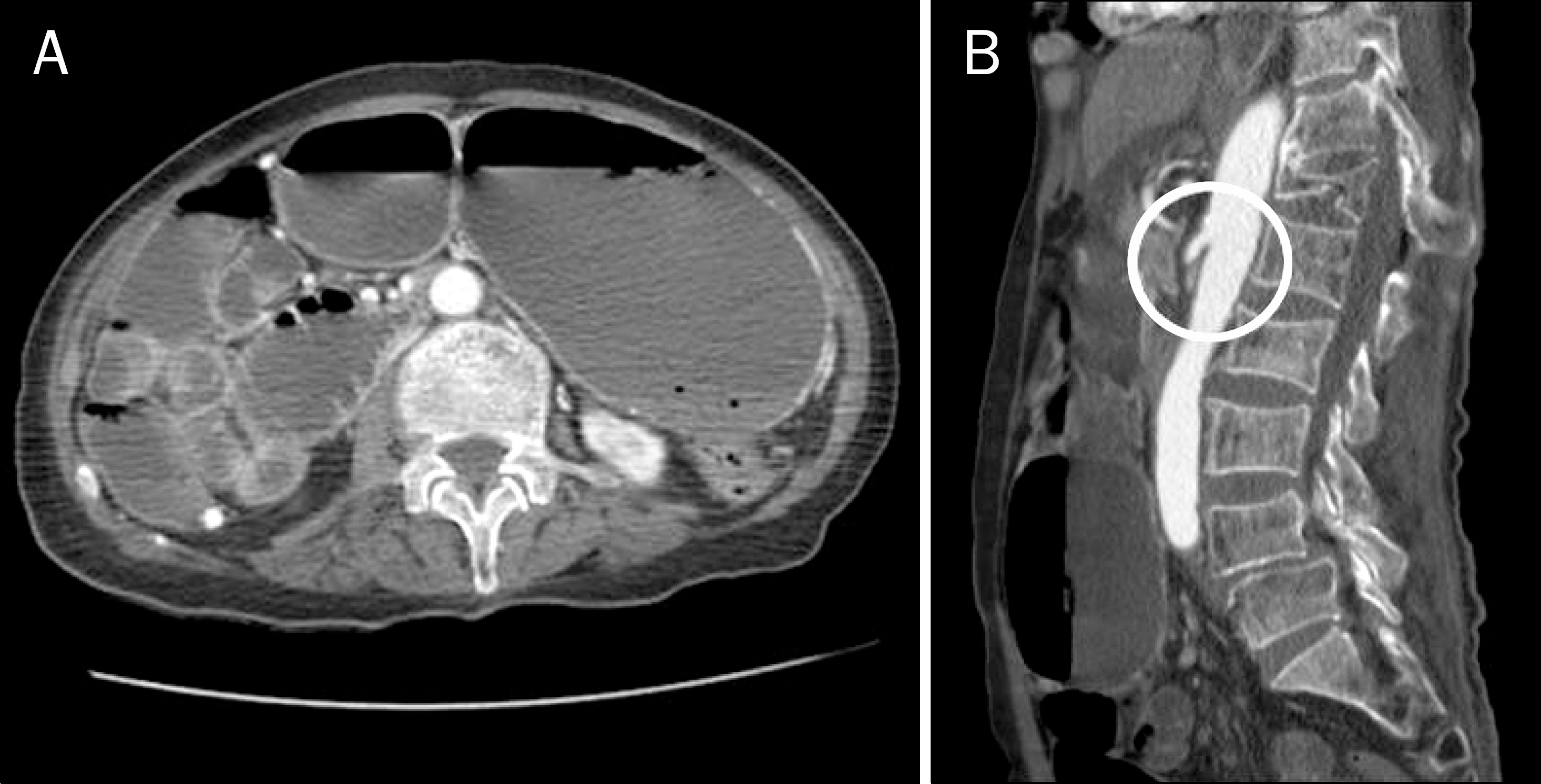
Fig. 3.
Radiograph showing combined nasogastric and nasoenteral tube placement. (A) A nasoenteral tube was inserted into the duodenum through the pylorus in the presence of a former nasogastric tube (dark arrow). (B) Contrast dye injection was performed to confirm the intrajejunal location of the tube tip (white arrow).
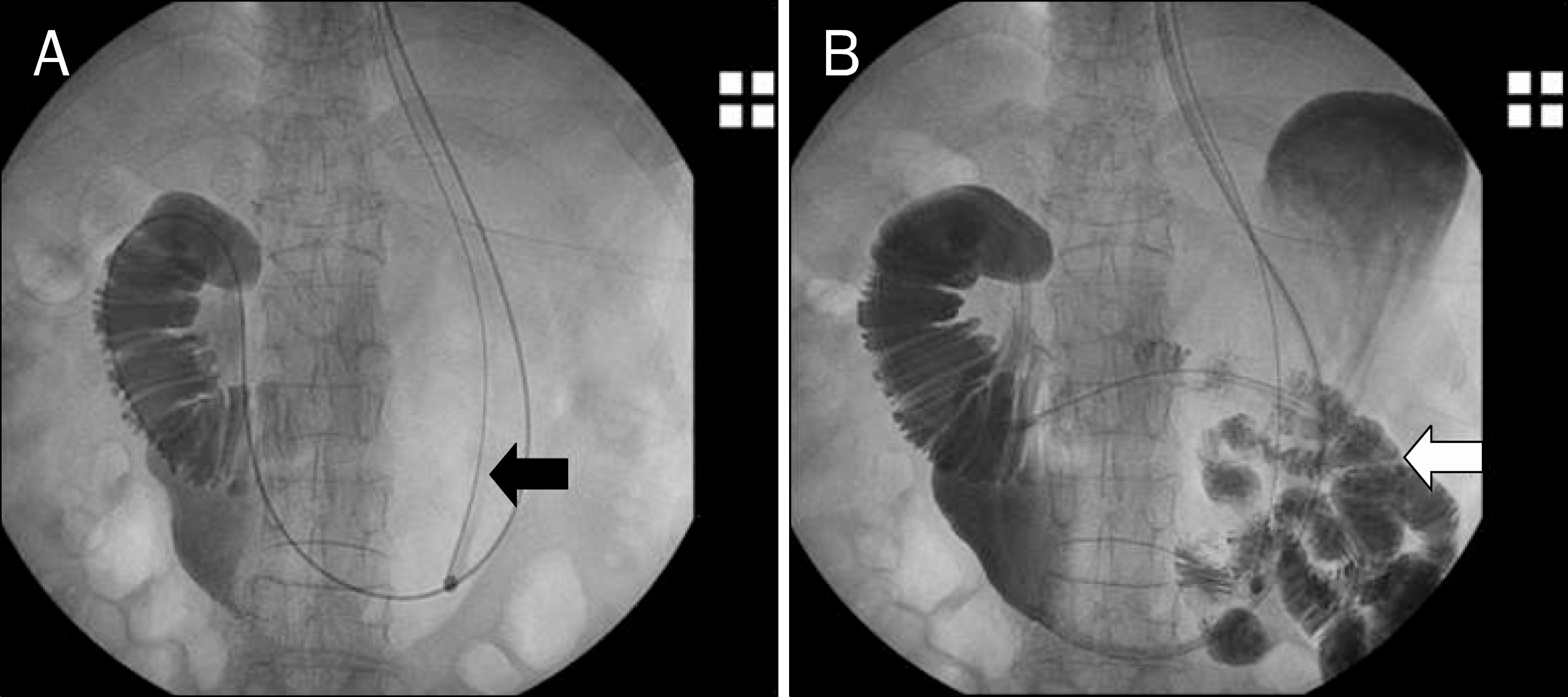




 PDF
PDF ePub
ePub Citation
Citation Print
Print


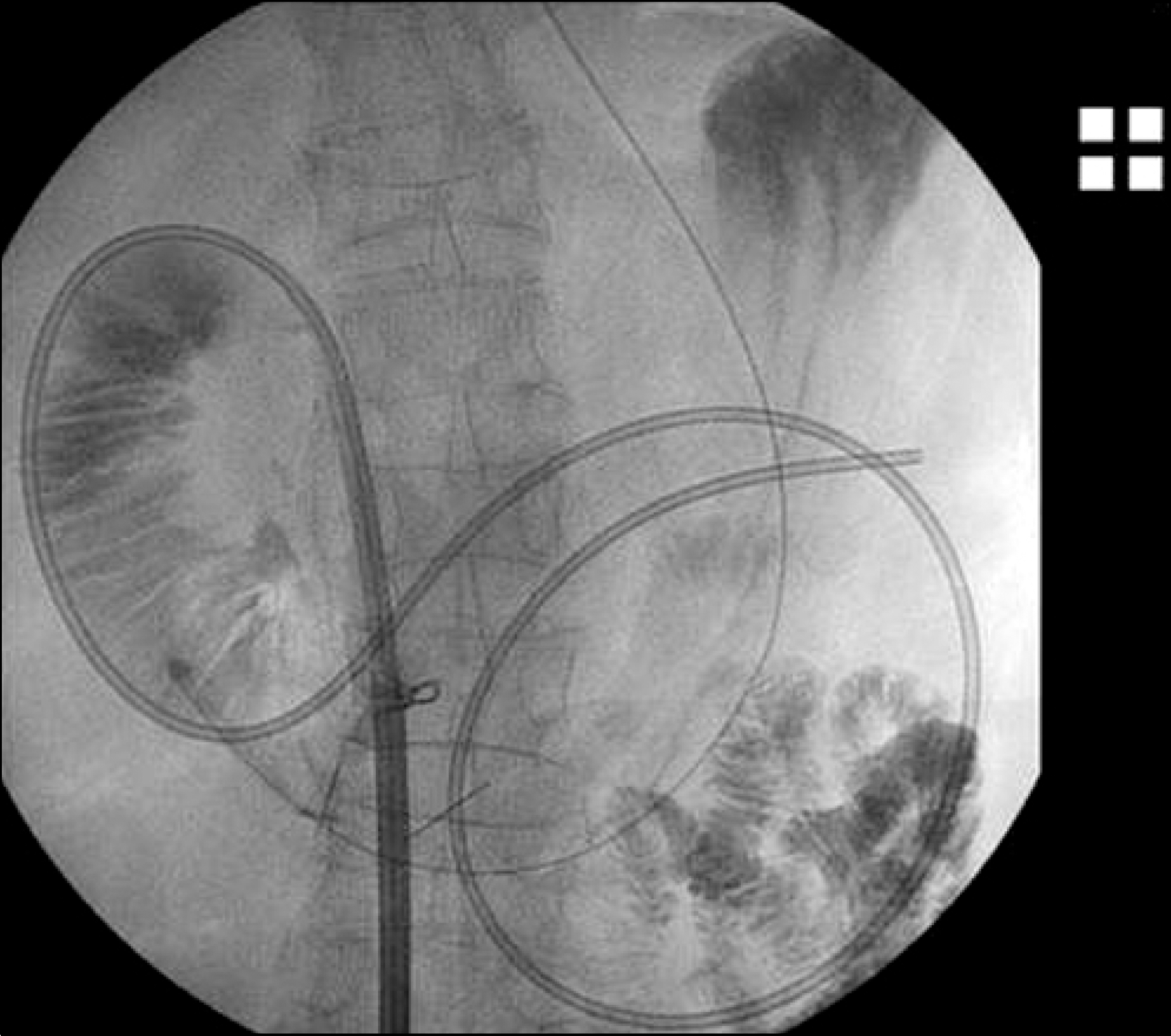
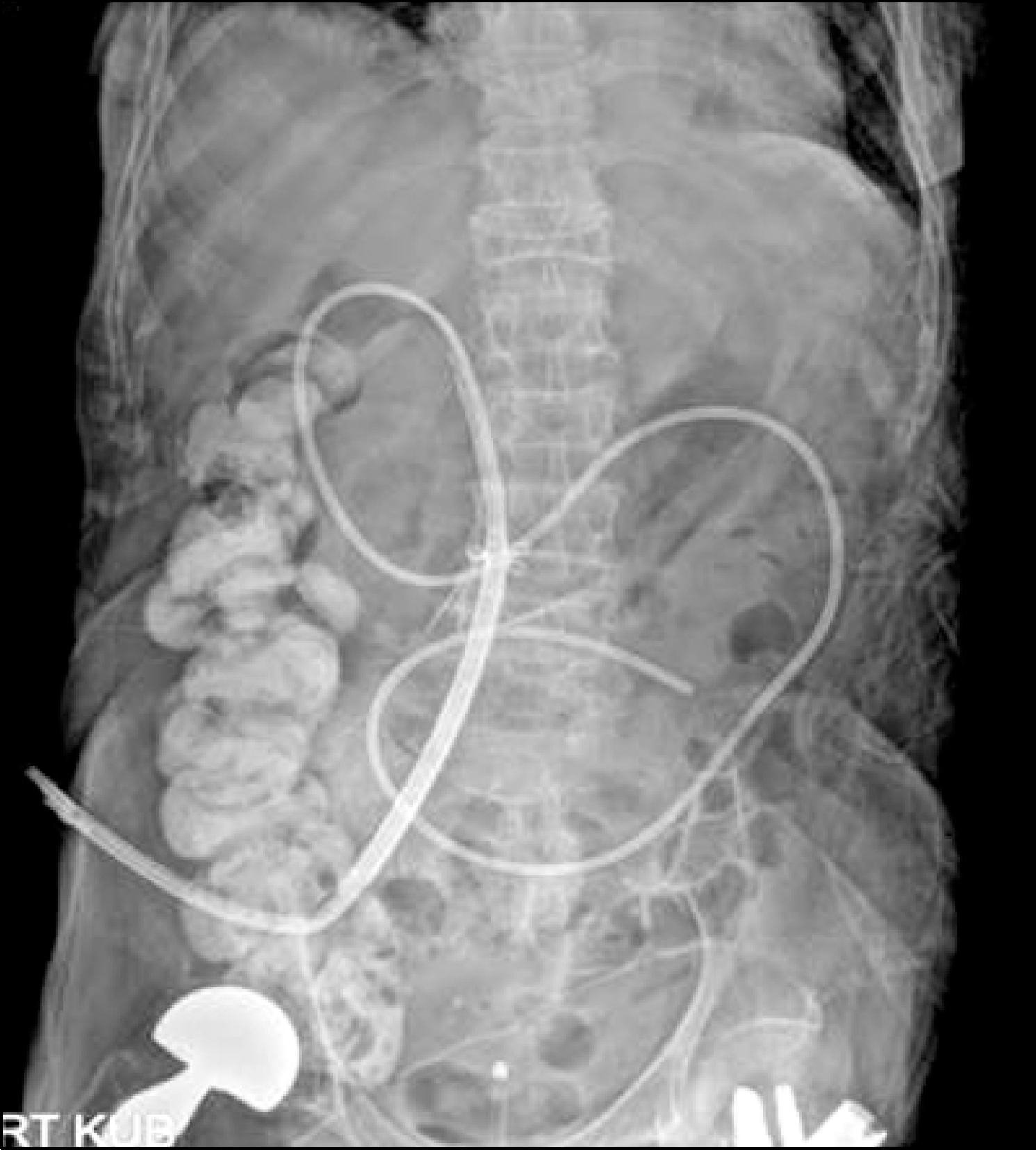
 XML Download
XML Download